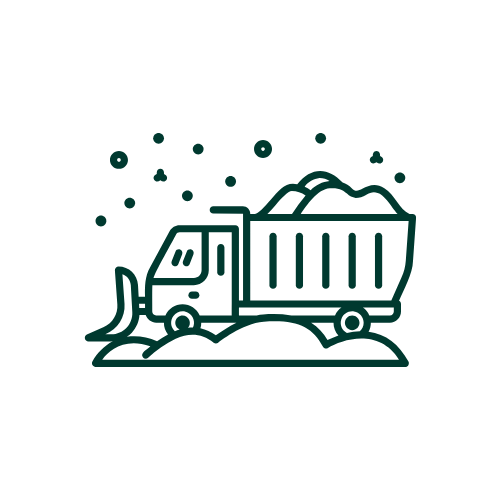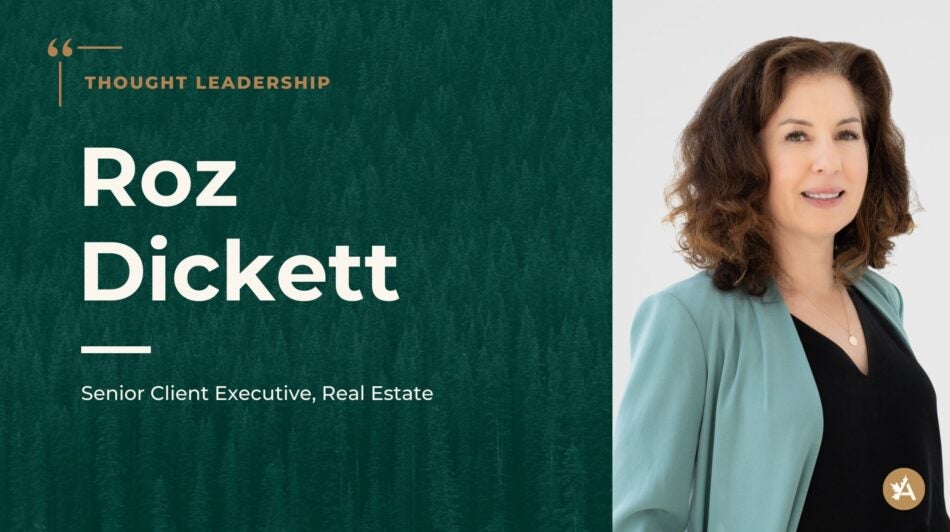Slip and fall injuries are one of the most common sources of legal claims against strata or condo corporations. During winter, these accidents rise sharply as snow and ice accumulate in walkways and common areas. Engaging professional snow removal providers is one of the most effective ways to protect your strata or condo corporation during these conditions, and many insurers now require it as a condition of coverage.
Drawing on more than 20 years of insurance and risk management experience specializing in property management, Roz Dickett, Senior Client Executive, Real Estate, shares best practices when contracting these services to limit your legal exposure and improve your defence against potential claims.
Best practices when contracting snow removal services for your condo or strata corporation
One of the key advantages of hiring professional snow removal providers is the ability to transfer risk away from your strata or condo corporation. This is achieved with the simple step of being added as an additional insured on the contractor’s insurance policy.

If a slip and fall claim arises, the contractor’s commercial general liability responds first to cover defence costs and any resulting settlements for both your strata or condo corporation and the contractor. This clause in your service agreement is one of the most effective risk management measures you can take to minimize liability during the winter.
To further reinforce your cold-weather risk management strategy, our in-house risk management team – with decades of experience advising building owners and managers on loss prevention – recommends these complementary best practices:
Request proof of insurance
Each year, request an updated certificate of insurance from the contractor that confirms:

Your strata or condo corporation is named as an additional insured

A coverage limit of at least $2 million (although $5 million is ideal)

30 days’ written notice of cancellation or non-renewal (so you are informed and can respond in advance of any lapses of coverage)
Ensure services are activated automatically upon snowfall
Your written contract or service agreement should specify in detail:

The parameters under which services are automatically dispatched (e.g., once certain weather conditions are met)

Clear timelines for response (e.g., removal beginning within a set number of hours after snowfall starts)

The conditions under which products such as salt are to be applied and areas of application
Automatic activation helps avoid dangerous delays and ensures timely treatment. You should also require that contractors return as needed to address re-freezing or new accumulation, particularly during freeze/thaw cycles. If you are in a coastal location, consider additional precautions such as salting whenever temperatures drop to or below 0°C or pre-salting in advance of frost, ice or snow warnings. Snow and slush can melt during the day and refreeze overnight into ice.
Use reputable snow removal contractors
Whenever possible, engage established snow removal companies with a proven track record in your community. These providers are more likely to carry proper insurance, maintain reliable equipment and employ trained crews who understand both safety protocols and industry standards. Don’t assume smaller or independent contractors can’t meet the same standards, but do always verify that they follow recognized best practices for snow and ice management.
Provide a site map and identify priorities
By visually identifying high-hazard areas, you give contractors clear direction on where attention is needed most. These commonly include:

- Entrances
- Stairs
- Ramps
- Accessible routes
- Mailboxes
- Crosswalks
- Heavy-use walkways
Alongside the map, establish priority sequencing for service. For example, entrances and stairs should be cleared first to maintain safe access for residents and visitors, while secondary areas can follow. This ensures the most critical zones are addressed quickly and demonstrates that your strata or condo corporation has taken reasonable steps to prevent accidents.
Maintain logs and documentation
Accurate records are one of the most important tools your strata or condo corporation can rely on if a slip and fall claim arises. Confirm that contractors maintain detailed snow removal logs that capture the timing, frequency and scope of work completed during each visit. Your strata or condo corporation should also keep copies of these records on file and supplement them with your own documentation when necessary. Recording any snow and ice management done by your own staff (such as applying salt or sand in common areas) is equally important. Together, this documentation demonstrates due diligence and can be critical evidence in defending against liability claims.
Establish an incident protocol
Having a clear, documented process for reporting incidents ensures you can respond quickly and effectively, while preserving important evidence for potential claims. Your protocol should include steps for immediately gathering and recording:

Time-stamped photos of the area where the incident occurred.

Site and weather conditions, such as temperature, precipitation or visible ice buildup.

Contractor contact information, including who was responsible for snow removal at the time.

Witness details, with names and statements if possible.
Designate a person or team who will be responsible for collecting and storing this information in a central, accessible file so it can be quickly provided to insurers if a claim is made.
Reduce your strata or condo corporation’s exposure to liability this winter
While slip and fall incidents are one of the most frequent causes of liability claims for strata and condo corporations, they’re also among the most preventable. Protecting your property and residents during the winter months comes down to preparation. Each of these simple but powerful steps plays an important role not only in creating a safer environment for your community, but also in supporting your defence against claims. The real estate specialists at Acera Insurance can also review your contracts to help ensure you’re transferring risk appropriately and avoiding unnecessary liability.
Be certain your strata or condo corporation is ready for winter — connect with an Acera Insurance advisor today to assess your coverage and strengthen your risk management plan.
FAQs
Many insurers now expect strata and condo corporations to work with professional snow removal contractors because it demonstrates due diligence and proactive risk management. Professional providers carry their own insurance, maintain detailed service logs and follow recognized industry standards for timing, treatment and safety. These factors help reduce the frequency and severity of slip and fall claims, protecting both the strata or condo corporation and the insurer from preventable losses.
Slip and fall claims are typically covered under a commercial general liability (CGL) policy, which insures against claims of third-party bodily injury or property damage that occurs on your property. For strata or condo corporations, this means your CGL policy may respond if someone is injured due to snow or ice on common property. However, if your snow removal contractor is properly insured and your strata or condo corporation is listed as an additional insured, their policy will respond first so you can avoid filing a claim.
Hiring a professional, insured contractor not only ensures the work is done safely and consistently, but also allows responsibility to be shifted in the event of a claim. However, if your insurer does not require you to use professional snow removal services and you choose to handle it yourselves, we highly recommend maintaining detailed logs of any snow removal and salting done. These records can be critical evidence to show that you took reasonable steps to maintain safe conditions for residents and visitors.
This can happen if the contractor’s coverage has lapsed or is insufficient to cover the claim amount; the incident happened in areas or circumstances outside the contractor’s responsibility; the claim alleges negligence on the part of the strata or condo corporation; or the contractor’s insurer denies coverage due to exclusions or breach of terms. In these cases, coverage under your strata or condo corporation’s policy may be required to defend or share in the cost of the claim.
Share this article:

Get weekly tips to protect your business!
Subscribe to our LinkedIn Newsletter. Our advisors’ insights will help you Be Risk Ready.
Roz Dickett brings 21 years of real estate risk management and insurance experience and proudly works with Vancouver’s leading property managers and developers. Connect with Roz at 604.484.0203 or roz.dickett@acera.ca.
Related reading:
- Liability insurance considerations and best practices for real estate owners and managers
- Why real estate insurance requires a specialist – not just a policy
Information and services provided by Acera Insurance, Acera Benefits and any other tradename and/or subsidiary or affiliate of Acera Insurance Services Ltd. (“Acera”), should not be considered legal, tax, or financial advice. While we strive to provide accurate and up-to-date information, we recommend consulting a qualified financial planner, lawyer, accountant, tax advisor or other professional for advice specific to your situation. Tax, employment, pension, disability and investment laws and regulations vary by jurisdiction and are subject to change. Acera is not responsible for any decisions made based on the information provided.

